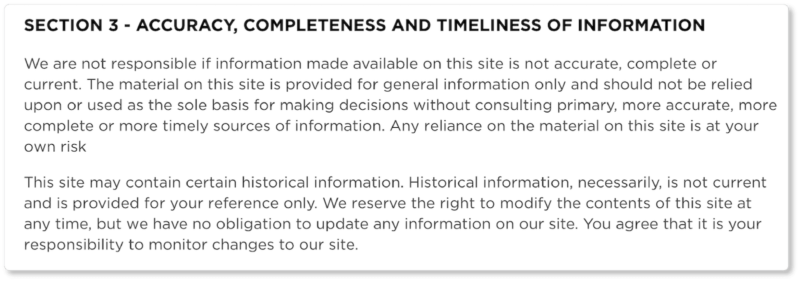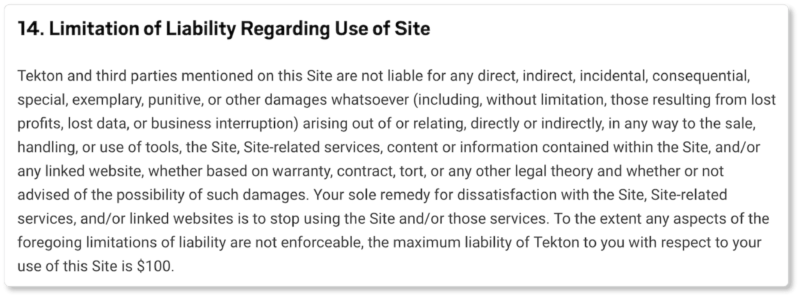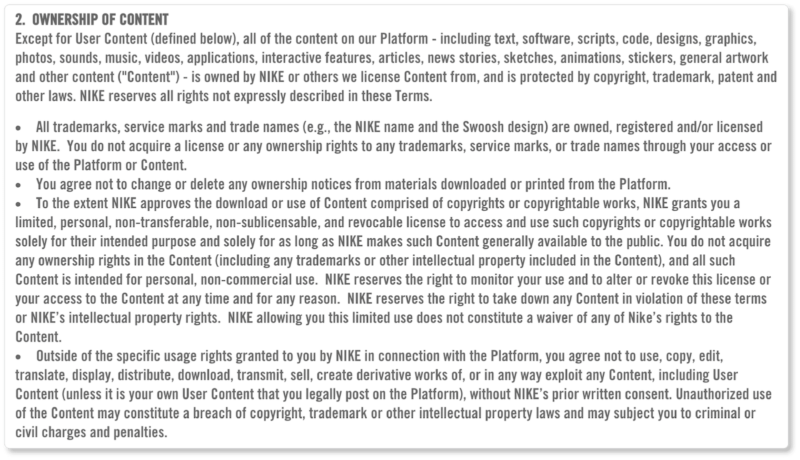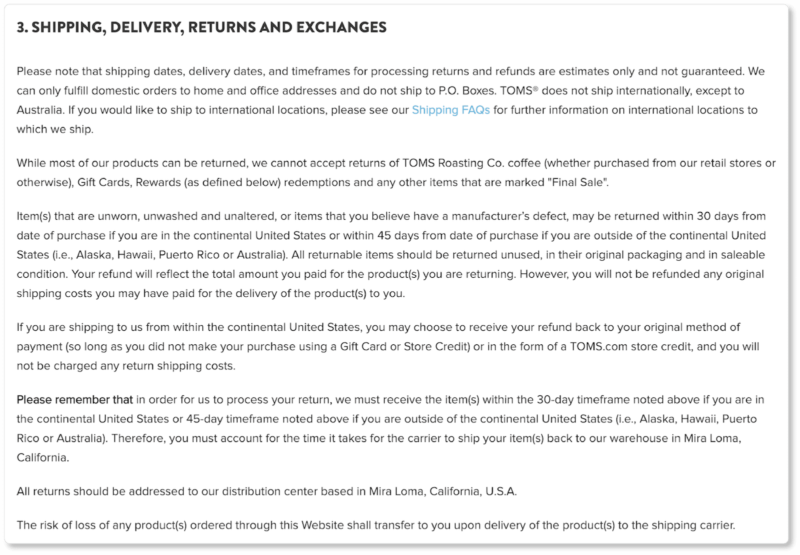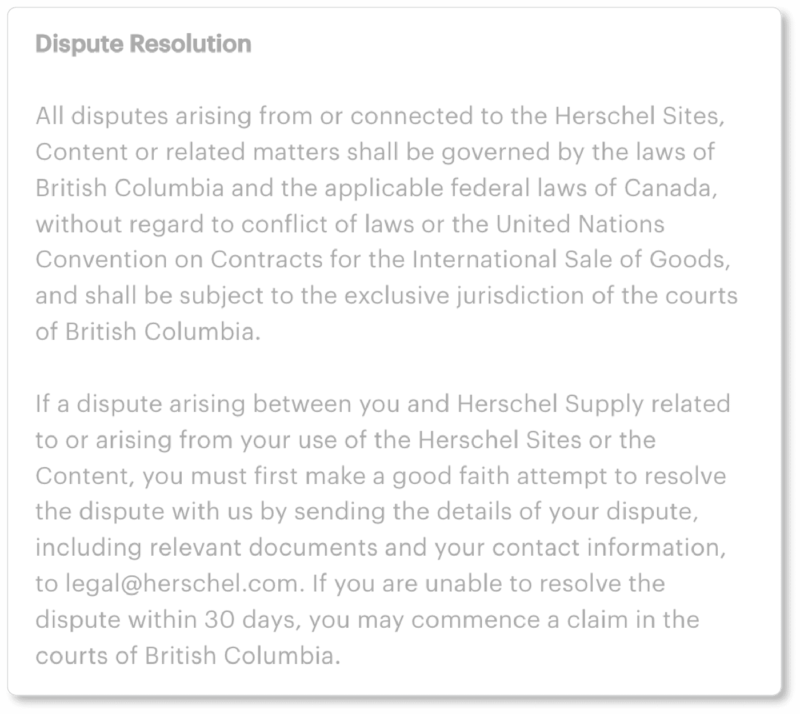- HOME
- Ecommerce
- Building Your Ecommerce Website
- Creating the Terms & Conditions for Your Ecommerce Site
Creating the Terms & Conditions for Your Ecommerce Site
- 14 Mins Read
- Posted on March 2, 2019
- Last Updated on October 8, 2024
- By Lauren
In previous sections, we’ve covered some important policies you’ll want to display on your ecommerce site (and elsewhere): your shipping policy, your Returns & Refunds policy, and your privacy policy. We’re nearly finished with the legal communications; but we’ve got one more document to cover: your Terms & Conditions.
Before we jump in, a note on hiring legal help, since it’s something we’ve insisted upon when it comes to these documents. We know: There’s no visible ROI on your legal documents, so the costs may be hard to justify. But hiring legal help will be well worth the peace and security that comes with legitimacy—not to mention the potential legal quandaries it’ll shield you from. These are complex matters—perhaps the T&C in particular, because it encompasses so much. And there’s certainly no shortage of legal help out there to turn to, whether through online legal solutions like LegalZoom or LawTrades, or through your local attorney.
The costs of drafting a Terms & Conditions, of course, will depend on the complexity of your website: We’ve seen prices range anywhere from $350 to $5,000. You may decide your energies need to go toward other aspects of running your business, and you’ll leave your T&C (and other documents) in a lawyer’s hands… and that’s a great decision. But if keeping costs low is a priority—and that’s a great decision too!—you can cut costs by drafting your own T&C first, and hiring legal help for the review process. The cost of review will then depend on how well you did your research and considered the inner workings of your own business.
If you’re clear you want to start and end with legal help, feel free to skip this section and head over to the final stage of setup: ecommerce integrations. This page is for those of you who think it makes sense to draft your own T&C first.
What are Terms & Conditions?
A “Terms & Conditions” (also called a “Terms of Service” and “Terms of Use”) is a document that explicitly sets out the boundaries and expectations of all parties involved in your ecommerce site: the code of conduct you expect visitors to adhere to if they want to browse your website or purchase your products, and the roles and responsibilities they can expect your business to fulfill. Think of it as a general set of rules that will govern your relationship from beginning to end.
We’ll talk at greater length about the topics it covers below; but broadly, you can expect your Terms & Conditions to cover topics such as ownership of site content, acceptable and unacceptable uses of the site, owner accountability, payment methods and terms, guarantees and warranties, disclaimers, limitations of liability, dispute resolution procedures, account termination procedures, and more… as well as some of the topics we’ve already covered in this content (shipping, returns, privacy).
Unlike your privacy policy, your Terms & Conditions isn’t legally required… but it’s highly recommended. Here are a few reasons why:
Why Do I Need Terms & Conditions?
As you can probably tell based on the list of topics it covers, there are plenty of reasons to offer a Terms of Service on your ecommerce website. These reasons extend far beyond transparency and prospect trust—though let’s be honest, prospect trust should be reason enough to offer them. A Terms & Conditions can save you time, money, and headaches by addressing all possible issues at the outset. It clarifies your business practices, protects your intellectual property (along with your site and your service), and limits your liability. It informs users how you plan to handle every interaction and transaction with them, saving both time and confusion down the line. It’s a preventative measure for complaints and disputes. How will you deal with non-payment? With faulty goods? These are the kinds of questions your T&C answers. Visitors who read it should know exactly what to expect in every possible scenario with you.
While there’s no legal requirement, a Terms & Conditions certainly provides legal protection. (Indeed, having a T&C might deter consumers from seeking legal compensation from you.) If you ever end up in a legal battle, the court will look to your website’s Terms & Conditions to examine the contractual terms you’ve laid out. If you don’t have a T&C—or if you wrote yours without legal guidance—your case is less likely to hold up in court. So while it’s likely that few, if any, users will ever read your small print, it’s a powerful legal tool should it ever become necessary. Naturally, it’s in your best interest to make this document comprehensive.
What Should My Terms & Conditions Include?
The specifics will be unique to your offering and operations, but there are some basic elements that every ecommerce Terms of Service should cover. The following is not an exhaustive list! Review the T&Cs of competitor sites to uncover other elements specific to your industry. If you sell apparel, look at other online apparel retailers and pay attention to the topics their terms cover. If your site allows users to post reviews and comments—on product pages or on your blog—look at some sites with those capabilities and see how they discuss those features in their Terms of Service. And so on.
With that recommendation, there are a few things to keep in mind. While your Terms & Conditions needs to be comprehensive, it should also be as clear and concise as possible. Make it user-friendly for anyone who does take the time to look at it. For example, consider styling it with anchor tags so users can jump right to the topic they want to know about, or offering an accordion interface so users can expand the section they want to read. Maintain a friendly voice. Your T&C isn’t meant to be imposing or intimidating; it forms the groundwork of the relationship between your business and its prospects. Finally, keep customers and site visitors in the forefront of your mind at all times. This isn’t just about the document; it’s about the terms themselves. Consider what you’d expect or hope for as a customer of your own business. This will help you keep your terms fair and reasonable.
Conditions of use
The conditions of use—which you should open with—serves a few purposes. In the first place, it identifies you: You’ll state your company’s legal name and address, your country of registration, your registration number, and/or your tax details (Sales Tax ID number, VAT number etc.). You might even offer a brief description of the products you provide and the content and features you offer on your website, as Carbon38 does:
 In the second place, the conditions of use doubles as an acceptance of terms on the visitor’s part: You’ll state that participation in the site equals consent to the agreement. This ensures that the subsequent terms are legally enforceable. If you’ve spent any time looking through T&Cs, you’ve probably read something like: “If you visit, browse, or shop on this site, you accept and are bound by the conditions in this agreement. Please read them carefully.” It doesn’t hurt to put this in bold or uppercase font, as Happy Socks and Apple do. (Notice how both companies clarify defining terms in parentheses):
In the second place, the conditions of use doubles as an acceptance of terms on the visitor’s part: You’ll state that participation in the site equals consent to the agreement. This ensures that the subsequent terms are legally enforceable. If you’ve spent any time looking through T&Cs, you’ve probably read something like: “If you visit, browse, or shop on this site, you accept and are bound by the conditions in this agreement. Please read them carefully.” It doesn’t hurt to put this in bold or uppercase font, as Happy Socks and Apple do. (Notice how both companies clarify defining terms in parentheses):
Product information and warranties
In this clause, you’ll describe how products can be purchased, what restrictions there are to purchase (age restrictions, for example), and what happens in the event that you can’t supply a product. This is also an appropriate place to include warranty information if you provide one—though depending on the nature of your products, you may offer a separate warranty policy. Do you have limits on the number of products a customer can purchase? Do you reserve the right to reject customers’ orders for any reason and at any time? What happens when you receive a valid warranty claim from a customer for a product they purchased from you? What if you can’t repair or replace within a reasonable timeframe? And so on. It might take time to come up with questions for every possible scenario; but this is where legal help will be valuable.
Here’s how Swatch and Milk Makeup deal, respectively, with merchandise availability and warranties (or, in Milk’s case, a lack thereof):
Disclaimer of liability
You may have noted in the excerpt from Milk’s terms above that their “disclaimer” covers more than product warranties. Milk also disavows that its site functions are error-free, and that the content on its site is 100% correct, accurate, or reliable. This is an important clause to include. Your statement might read something like: “This website and its component parts are presented for informational purposes only. This site shall not be held responsible or liable for the accuracy or usefulness of any of the information available on it; nor shall it be held responsible or liable for any omissions or errors in that information.”
A provision like this will shield you from legal liability for any errors on your site, or in the case that a visitor suffers negative consequences for having relied upon your site information, or their computer is infected with a virus from your site, or they experience injuries while interacting with your site… imagine your worst-case scenario, and cover it. Furthermore, if users can post content to your website, your Terms & Conditions should disclaim your liability from any offensive or derogatory postings. Absolve yourself of responsibility for statements made by third parties, and clarify that you don’t endorse the opinions or positions of your users.
“Limitation of liability” (also called “indemnification”) doesn’t just concern site content, however. It also pertains to the product itself. Of course, the information in this clause will depend upon the nature of the goods you’re selling; the point is to draw the line regarding damages, risks, loss, personal injury, and so on that a visitor may suffer during or after transactions with your business. What will you cover in the event of product failure? What are the risks (direct, indirect, or consequential) involved in your product? Here are two examples from York Athletics Mfg. and Tekton:
Permitted use
This clause covers user behavior. You’ll explain proper and expected usage of your website and define misuse. This clause is important because it allows you to close users’ accounts with your store if they infringe or violate expected behavior or conduct. “Use” might include rules on sharing, downloading, commenting on blog posts, reviewing products on your site, and more. Don’t want minors browsing your website? Say that here. Have requirements for creating an account with you? Say that here. Don’t want obscene, defamatory, or threatening comments in your blog comments? Say that here. Don’t want to be spammed with solicitations, political campaigns, or software viruses? Say it. Don’t want visitors to impersonate others or use fake email addresses when contacting you? Put it here. And so on. Here’s how BlackMilk Clothing approached this clause:
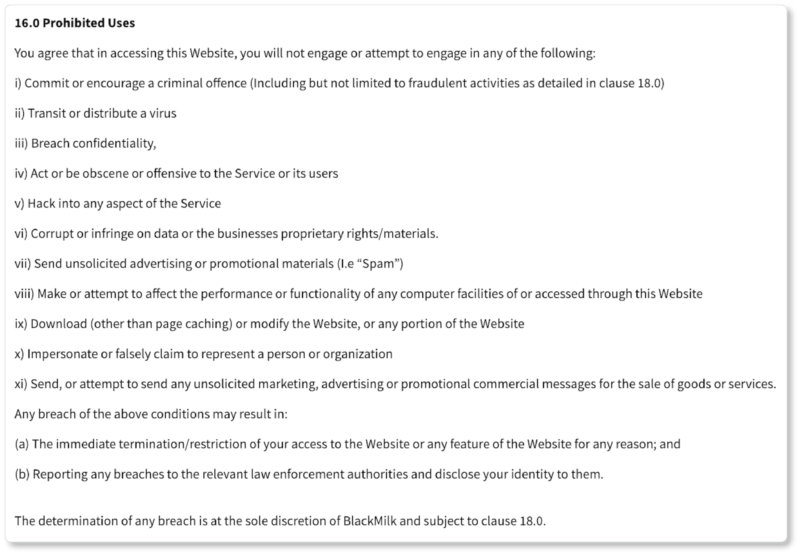 “Permitted use” might also cover how you are allowed to use content or material submitted to your company or posted on your website. (For example, you might want the right to reproduce or publish customers’ comments as testimonials.) Here’s York Athletics again:
“Permitted use” might also cover how you are allowed to use content or material submitted to your company or posted on your website. (For example, you might want the right to reproduce or publish customers’ comments as testimonials.) Here’s York Athletics again:
Intellectual property and trademarks
This could fall under “permitted use”; but intellectual property is often given its own clause… and for good reason. After all, you’re only giving users the right to access your site for a limited time—and only for the purposes the site was set up for. You don’t want users downloading, modifying, reproducing, repurposing, or distributing any of the content you’ve worked so hard to create. Protect your site’s images, videos, graphics, and copy. Protect your business name and logo, your brand image, and your product names. This clause should—where possible—list the specific content protected by copyright laws: logos, text, images, taglines, graphics, icons, etc. State the repercussions for stealing your property. And close (or open) your policy with “Copyright © 2019. mywebsite.com.” Here’s how Nike does it:
Conditions of sale
Your conditions of sale clause should inform visitors of payment terms, acceptable methods of payment, and how sales are processed. Your store likely accepts a variety of payment methods: debit card, credit card, PayPal, Apple Pay, and so on. Of course, visitors should see this list on your homepage or during checkout; but since your Terms & Conditions is a comprehensive document, list them here as well. Mention what currency your prices are in. Mention when payment is required. (Typically, full payment is required at the time the order is placed, which means your business is not required to provide goods until payment has been received). You might add that you won’t dispatch orders until payment is cleared, and that if a prospect’s payment doesn’t clear, you reserve the right to cancel their order.
How long does a customer have to cancel an order? If you offer subscriptions, what are the terms? (How often will customers be billed; what are the renewal terms and cancellation policy, etc.?) Do you reserve the right to change the prices listed on your site at any time? Do you have special fees or billing charges to mention? And so on. Any information you can imagine about payment details should go here. Camilla offers “conditions of sale” under two separate clauses: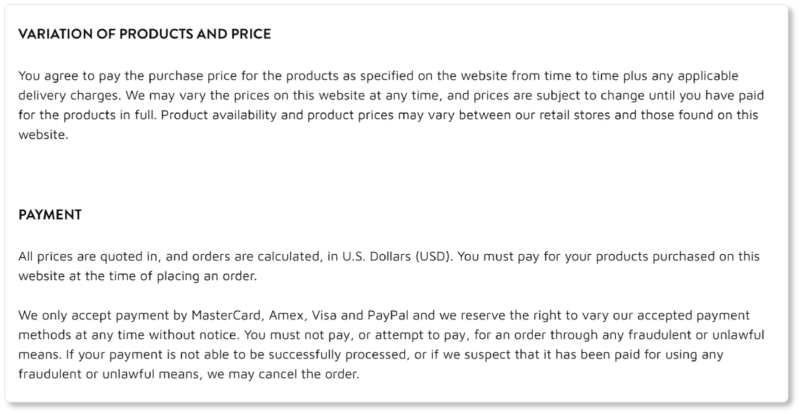 Note: You might offer a separate “right to cancel” clause. (Check the laws in your jurisdiction before writing this clause!) It will describe the circumstances under which customers can rightfully cancel their order, and the process they must follow to do so. Of course, you’ll link to your Returns & Refunds policy for more detailed information—the condition the returned product must be in, the timeframe it must be returned in, who pays for shipping, and so on—but you can summarize here.
Note: You might offer a separate “right to cancel” clause. (Check the laws in your jurisdiction before writing this clause!) It will describe the circumstances under which customers can rightfully cancel their order, and the process they must follow to do so. Of course, you’ll link to your Returns & Refunds policy for more detailed information—the condition the returned product must be in, the timeframe it must be returned in, who pays for shipping, and so on—but you can summarize here.
Delivery terms
Your delivery clause will summarize the terms laid out in your shipping policy: how shipping charges are calculated, what delivery options you offer (you might list couriers here), average shipping timeframes, and so on. The critical thing to mention here is that you can’t guarantee the quality of the delivery. After all, you’re using a third party for your shipping; and once the package leaves your hands, it’s the responsibility of your courier—not you—to get it to your customers in one piece. Here’s how TOMS does it:
Privacy
What are the steps you’ve taken to protect visitors’ and customers’ data? What are users consenting to (if anything) when they give you their email addresses? How will you communicate with prospects? How are cookies collected, managed, and used on your site? What other data are you collecting on site visitors? Whom are you disclosing it to? If you’ve been following along with us, you’ve already thought about your privacy policy. Your T&C should at least “nod” to it by linking out to it, as Breville does: But remember: This is the one part of your Terms & Conditions that’s legally required; so it doesn’t hurt to summarize it (or restate it) here, either!
But remember: This is the one part of your Terms & Conditions that’s legally required; so it doesn’t hurt to summarize it (or restate it) here, either!
External / third-party links
This one’s simple enough: If you link out to other sites from your ecommerce shop, you’ll need a clause that states both the links and the content they lead to are outside your control. Note that those links are there for the benefit of site visitors; but once a visitor leaves your site, they leave your realm of responsibility. Free People does it like this:
Dispute resolution
Your dispute clause will outline how you’ll approach and resolve conflicts, and clarify the law under which the dispute, arbitration, or mediation will be handled. (This is often called the “Governing Law” or “Choice of Law” clause. It reads something like: “These terms and conditions are governed by, and will be submitted to confidential arbitration under, the laws of the United States of America and the State of Massachussetts.”) Here are two examples from Plae and Herschel:
Right to modify terms
You’ll want to reserve the right to modify your terms (as well as the products you sell and the site features you offer) at your discretion, and when you see fit. If you want to do so without requiring user consent every time, include a clause in which you retain the ability to do so. Let users know that if they continue to use your site, it’ll signify their acceptance of your revised terms. Let them know how they’ll be notified of any changes to your terms. Maybe you’ll announce them on your homepage or other key pages; if they concern your privacy policy, you might notify users by email or postal mail before any of those changes go into effect. Maybe users are simply asked to return to your T&C on a regular basis to check for updates themselves. Warby Parkeropens their Terms & Conditions with this clause:
Other considerations
We couldn’t name every possible consideration here; but here are a few others to wake your mind up to the realm of possibilities. You might consider a “termination clause” informing visitors of your right to suspend or cancel user accounts if you observe (or suspect) abuse and misconduct. You might consider a clause reminding customers that they’re responsible for their own account maintenance and the confidentiality of their passwords. You’ll probably want specific provisions if you have user communities on your ecommerce site, or if you offer a site that either targets or is appealingto children under the age of 18 or 13. And so on. Again, look at the sites of other businesses in your industry. They’ll give you a sense of the additional terms you should offer.
Regardless of the other clauses you include, offer an easy way for visitors to get in touch with any questions they might have about your Terms of Service.
Additional Best Practices for Your Terms & Conditions
As is the case with your privacy policy, your T&C should be readily available to visitors in more places than your footer. (Though offering all documents as links in your website footer is standard practice and should be followed.) Link out to them from your confirmation emails and the communications from your email marketing campaigns. Link to them anywhere on your site that users have the option of entering personal information: near the comments section of your blog, at checkout, or near the subscription CTA, as BlackMilk Clothing does:
 You’ll notice that, for BlackMilk, clicking “Subscribe” is synonymous with agreeing to both their terms and their privacy policy. You’ll decide whether to get “active agreement” to your T&C: having users tick a checkbox saying they’ve read and agree to your terms. (This is called “clickwrap.”)
You’ll notice that, for BlackMilk, clicking “Subscribe” is synonymous with agreeing to both their terms and their privacy policy. You’ll decide whether to get “active agreement” to your T&C: having users tick a checkbox saying they’ve read and agree to your terms. (This is called “clickwrap.”)
Some ecommerce sites make active acceptance a condition of entry into the site, or a condition of sale. Doing so gives you an added degree of protection (it’s tougher for consumers to make the argument that they weren’t aware of your terms); but it can certainly add friction to the user flow—perhaps especially if you place the checkbox at checkout. Your decision may be product-dependent: If you’re selling “higher-risk” products like vitamins or beauty products, active agreement may be a good idea. Of course, you can always run some site tests to see how clickwrap alters your conversion rates.
Finally, keep up on the laws that preside over ecommerce in your jurisdiction. This isn’t exactly a document you’ll be updating regularly; but you’ll want to return to it on occasion to ensure it’s still relevant to your business activities… and still legal.
Congratulations! Your legal documents are written. In the last section, we turn to ecommerce integrations. No matter what commerce platform you’re using, you want to run a business that feels connected, automated, and run like a well-oiled machine. This means you’ll want your storefront integrated with email, CRM, live chat, and more.




